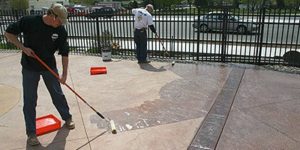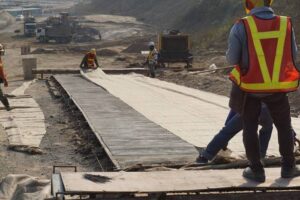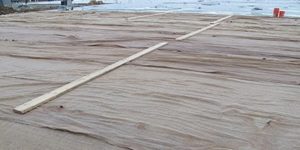
Photo courtesy of Jennifer Faller
Curing is defined as providing adequate moisture, temperature and time to allow cement to hydrate and concrete to develop internal strength and abrasion resistance. Properly cured concrete should be the goal for all concrete, not just polished.
There are different types of curing. These include:
- Wet cure involves a uniform puddle on the entire surface.
- Chemical cure dries and lies on the surface. It creates a film on the surface that eventually will become brittle, break and dust off.
- Wet blanket cure is when the slab is covered with a layer of water and then a physical cover/blanket is placed on top of it. This prevents the surface from drying for a set amount of time. Blankets come in many types, from reusable synthetic fiber and plastic to burlap and single-use applications.
What’s happening during cure time?
- Moisture in a newly poured slab slowly escapes upward to the surface. Whether cured or not, this means the slab’s bottom and middle are constantly in the presence of moisture.
- If not cured, the surface will dry rapidly due to air movement.
- The concrete surface gains its strength only when moisture is present.
- Curing allows moisture to evaporate slower. Water vapor travels upward when using a curing membrane. The moisture will dwell at the surface, producing a strong surface prior to escaping.
Here’s the tip
A strong, hard concrete surface is important because:
- When the diamonds cut the surface, they won’t rip out the smaller sand particles while cutting.
- The floor won’t be as pitted so the diamonds will cut cleaner.
- The surface won’t be as abrasive to the diamonds, giving the set of metals a longer life.
- There won’t be “dead” areas that simply won’t take on a shine.
- The concrete will polish up more uniformly because the diamonds will be working more uniformly.
- The surface won’t be blotchy (dark and light) from differential curing or noncuring.
- The surface will absorb similar amounts of densifier throughout the floor.
- The shine will ultimately be higher and the surface more durable.
Since you’re a craftsman of concrete, it’s important to learn about the material you’re working with. This knowledge can influence many decisions you make during a project. Or it simply may help you explain why something happened.
In the next tip, we’ll dive deeper into which type of cure you should recommend and why.
















